Chapter8 Exceptional Control Flow
8.1 Excepitons
In the figure, the processor is executing some current instruction Icurr when a significant change in the processor’s state occurs. The state is encoded in various bits and signals inside the processor. The change in state is known as an event.
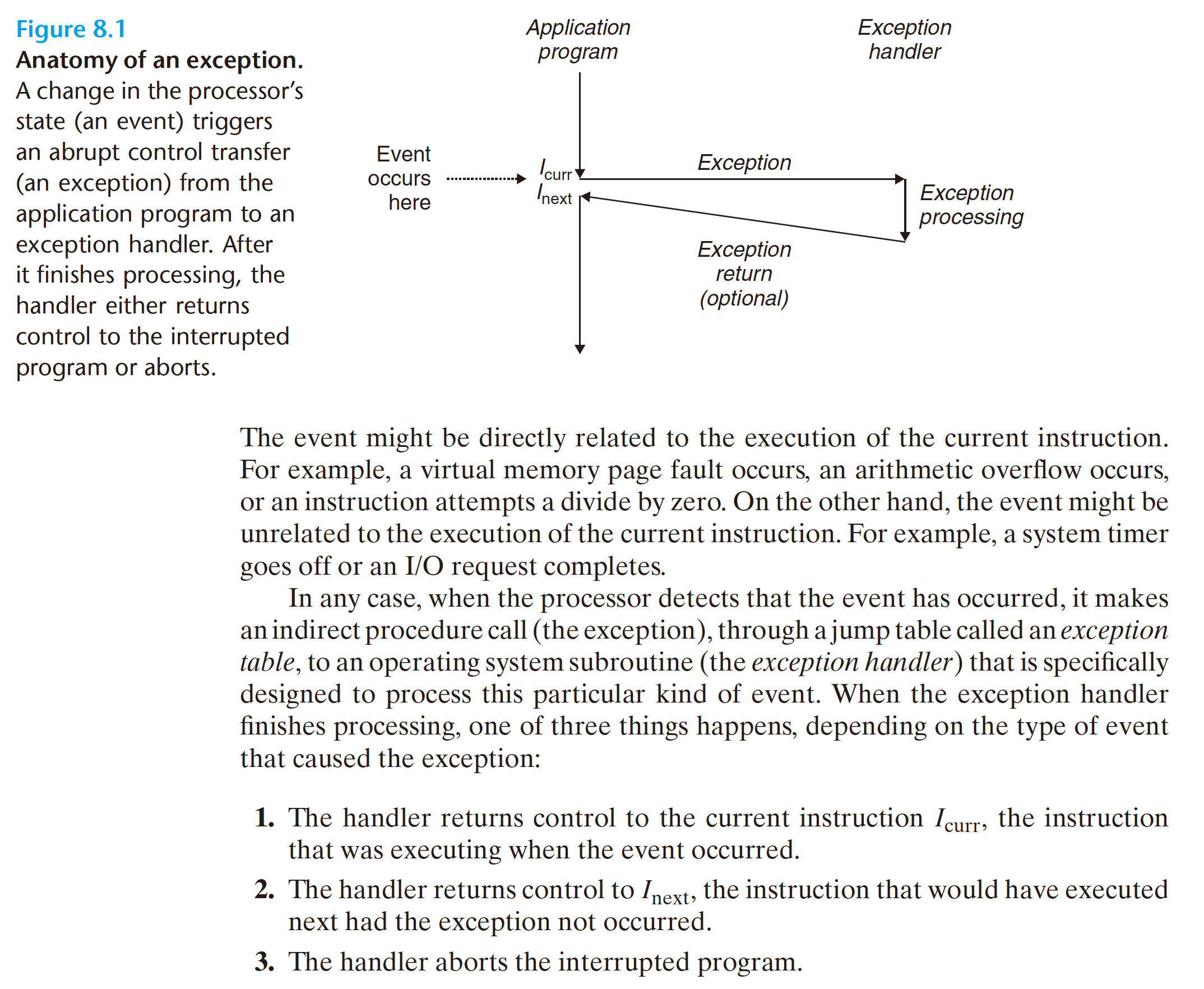
8.1.1 Exception Handling
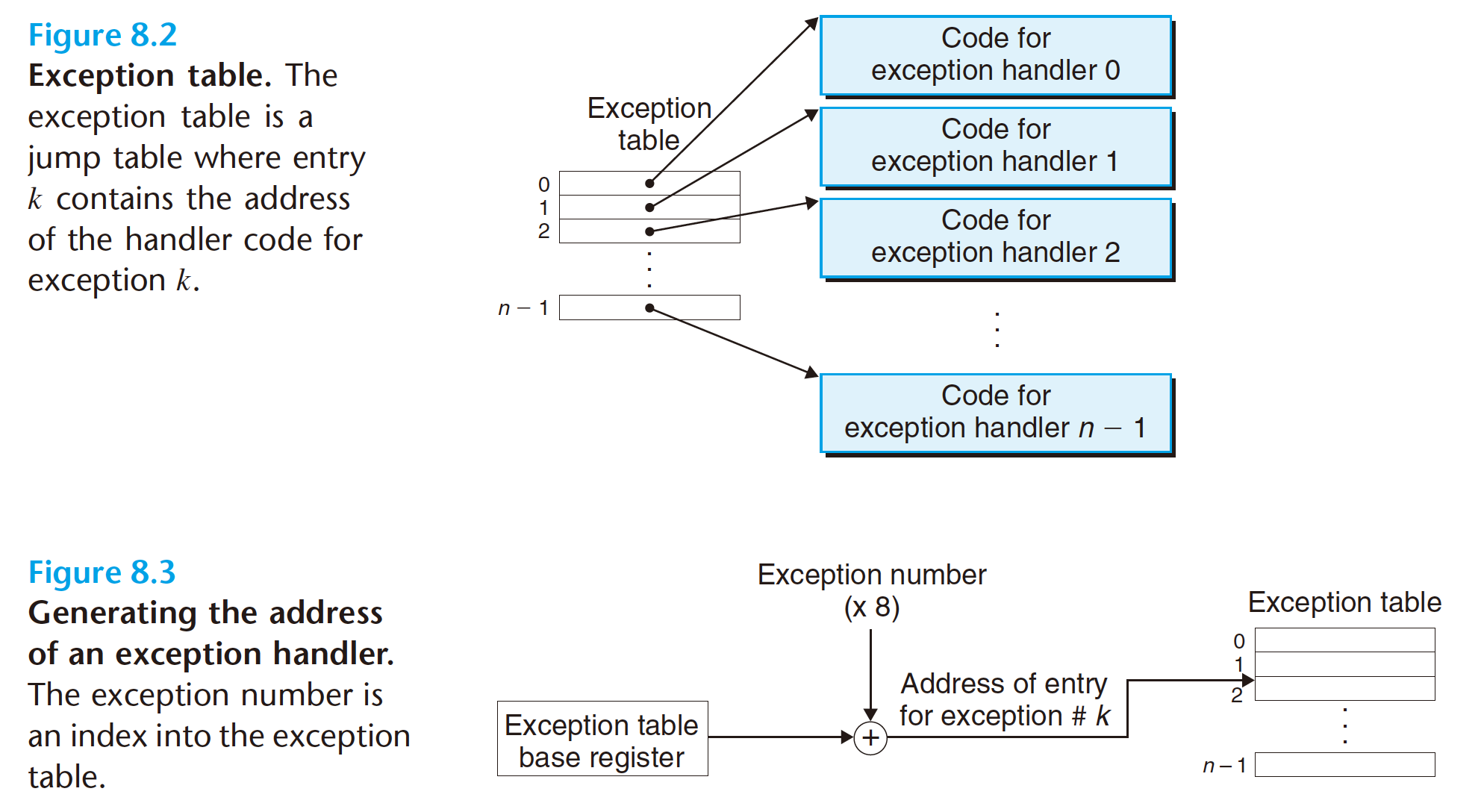
Each type of possible exception in a system is assigned a unique nonnegative
integer exception number. Some of these numbers are assigned by the designers
of the processor. Other numbers are assigned by the designers of the operating
system kernel (the memory-resident part of the operating system). Examples of
the former include divide by zero, page faults, memory access violations, breakpoints,
and arithmetic overflows. Examples of the latter include system calls and
signals from external I/O devices.
At system boot time (when the computer is reset or powered on), the operating
system allocates and initializes a jump table called an exception table, so that
entry k contains the address of the handler for exception k.
At run time (when the system is executing some program), the processor
detects that an event has occurred and determines the corresponding exception
number k. The processor then triggers the exception by making an indirect procedure
call, through entry k of the exception table, to the corresponding handler. Figure 8.3 shows how the processor uses the exception table to form the address of
the appropriate exception handler. The exception number is an index into the exception
table, whose starting address is contained in a special CPU register called
the exception table base register.
An exception is akin to a procedure call, but with some important differences:

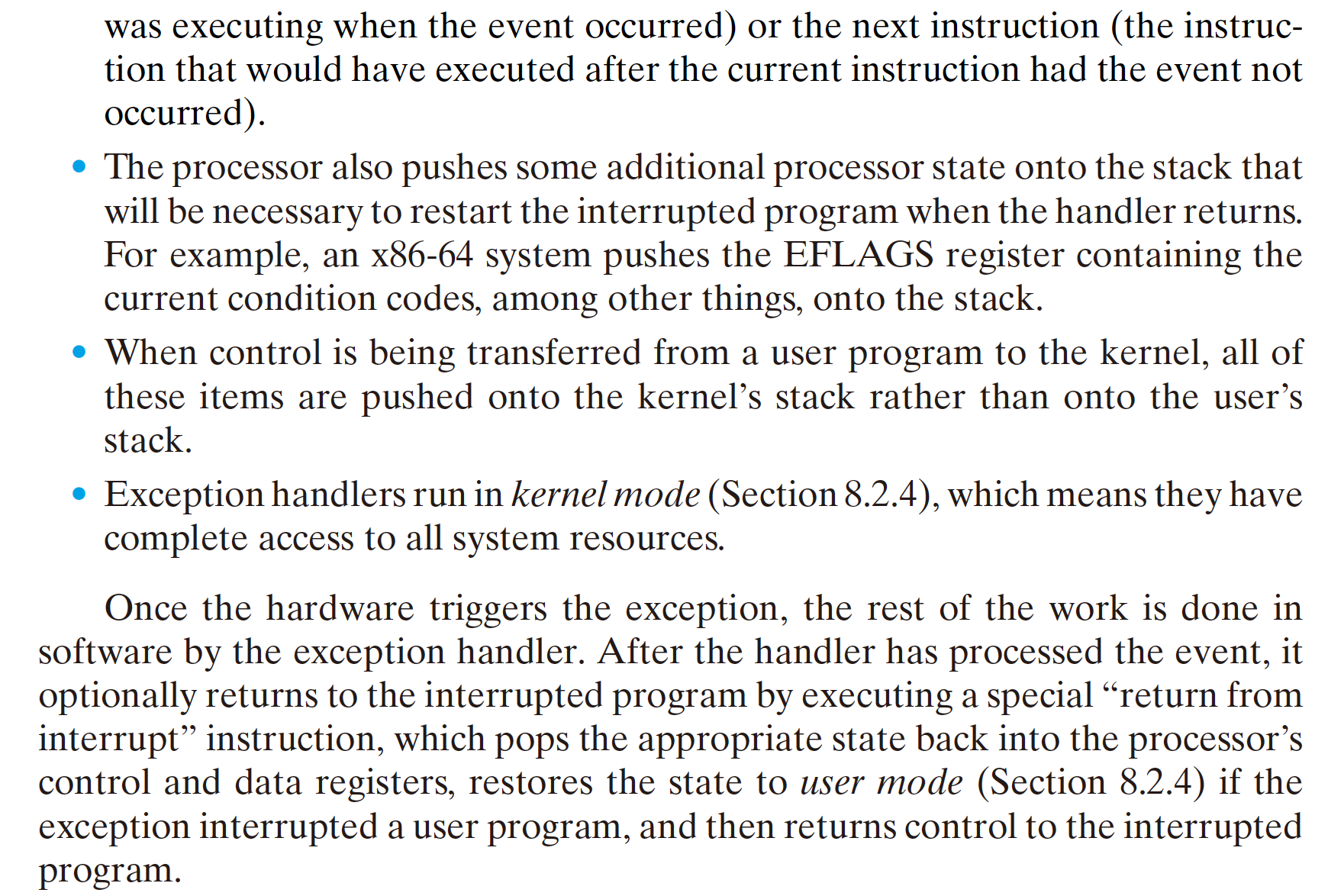
8.1.2 Classes of Excepitons
- Interrupts
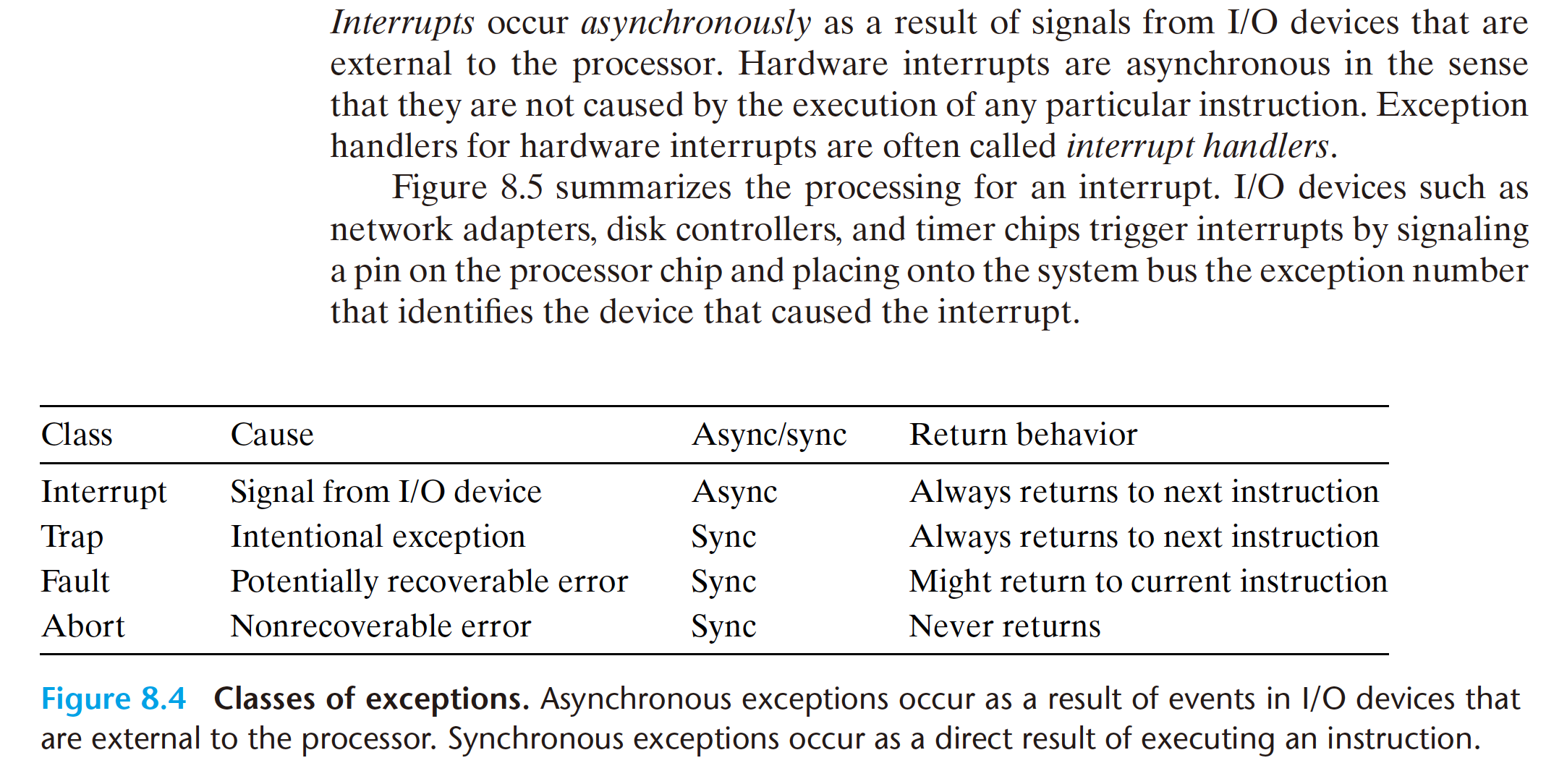
 After the current instruction finishes executing, the processor notices that the
interrupt pin has gone high, reads the exception number from the system bus, and
then calls the appropriate interrupt handler.When the handler returns, it returns
control to the next instruction (i.e., the instruction that would have followed the
current instruction in the control flow had the interrupt not occurred). The effect is
that the program continues executing as though the interrupt had never happened.
After the current instruction finishes executing, the processor notices that the
interrupt pin has gone high, reads the exception number from the system bus, and
then calls the appropriate interrupt handler.When the handler returns, it returns
control to the next instruction (i.e., the instruction that would have followed the
current instruction in the control flow had the interrupt not occurred). The effect is
that the program continues executing as though the interrupt had never happened. - Traps and System Calls
 Traps are intentional exceptions that occur as a result of executing an instruction.
Like interrupt handlers, trap handlers return control to the next instruction. The
most important use of traps is to provide a procedure-like interface between user
programs and the kernel, known as a system call.
Traps are intentional exceptions that occur as a result of executing an instruction.
Like interrupt handlers, trap handlers return control to the next instruction. The
most important use of traps is to provide a procedure-like interface between user
programs and the kernel, known as a system call.
From a programmer’s perspective, a system call is identical to a regular function call. However, their implementations are quite different. Regular functions run in user mode, which restricts the types of instructions they can execute, and they access the same stack as the calling function. A system call runs in kernel mode, which allows it to execute privileged instructions and access a stack defined in the kernel. - Faults
 Faults result from error conditions that a handler might be able to correct.When
a fault occurs, the processor transfers control to the fault handler. If the handler
is able to correct the error condition, it returns control to the faulting instruction,
thereby re-executing it. Otherwise, the handler returns to an
Faults result from error conditions that a handler might be able to correct.When
a fault occurs, the processor transfers control to the fault handler. If the handler
is able to correct the error condition, it returns control to the faulting instruction,
thereby re-executing it. Otherwise, the handler returns to an abortroutine in the kernel that terminates the application program that caused the fault. Figure 8.7 summarizes the processing for a fault.
A classic example of a fault is the page fault exception, which occurs when an instruction references a virtual address whose corresponding page is not resident in memory and must therefore be retrieved from disk. As we will see in Chapter 9, a page is a contiguous block (typically 4 KB) of virtual memory. The page fault handler loads the appropriate page from disk and then returns control to the instruction that caused the fault. When the instruction executes again, the appropriate page is now resident in memory and the instruction is able to run to completion without faulting. - Aborts
 Aborts result from unrecoverable fatal errors, typically hardware errors such
as parity errors that occur when DRAM or SRAM bits are corrupted. Abort
handlers never return control to the application program. As shown in Figure 8.8,
the handler returns control to an
Aborts result from unrecoverable fatal errors, typically hardware errors such
as parity errors that occur when DRAM or SRAM bits are corrupted. Abort
handlers never return control to the application program. As shown in Figure 8.8,
the handler returns control to an abortroutine that terminates the application program.
8.1.3 Exceptions in Linux/x86-64 systems
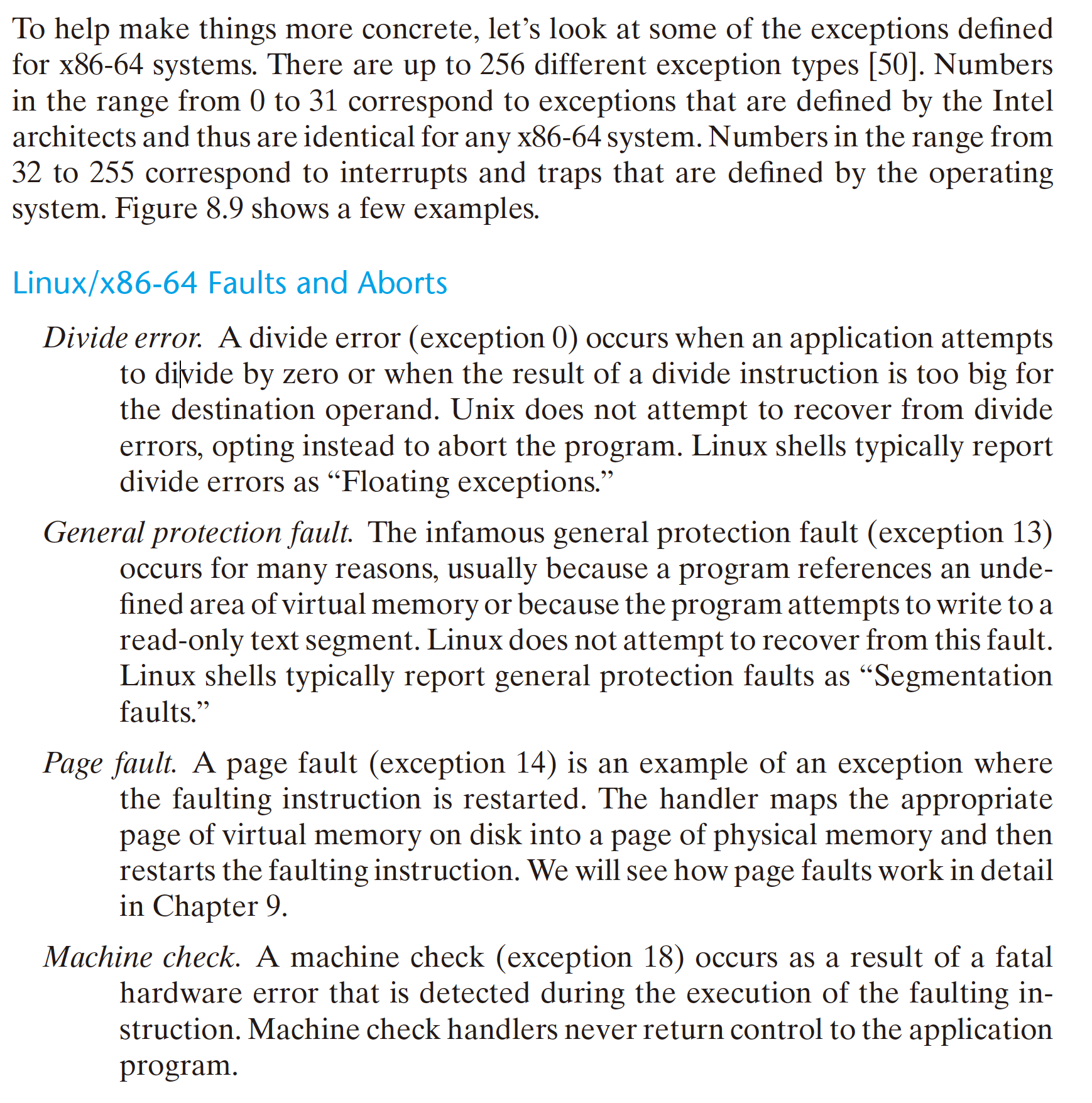
8.2 Processes
Exceptions are the basic building blocks that allow the operating system kernel
to provide the notion of a process, one of the most profound and successful ideas
in computer science.
When we run a program on a modern system, we are presented with the
illusion that our program is the only one currently running in the system. Our
program appears to have exclusive use of both the processor and the memory.
The processor appears to execute the instructions in our program, one after the
other, without interruption. Finally, the code and data of our program appear to
be the only objects in the system’s memory. These illusions are provided to us by
the notion of a process.
The classic definition of a process is an instance of a program in execution.
Each program in the system runs in the context of some process. The context
consists of the state that the program needs to run correctly. This state includes the
program’s code and data stored in memory, its stack, the contents of its generalpurpose
registers, its program counter, environment variables, and the set of open
file descriptors.
- An independent logical control flow that provides the illusion that our program has exclusive use of the processor.
- A private address space that provides the illusion that our program has exclusive use of the memory system.
8.2.1 Logical Control Flow
If we were to use a debugger to single-step the execution of our program, we would observe a series of program counter (PC) values that corresponded exclusively to instructions contained in our program’s executable object file or in shared objects linked into our program dynamically at run time. This sequence of PC values is known as a logical control flow, or simply logical flow.
8.2.2 Concurrent Flows
The general phenomenon of multiple flows executing concurrently is known as concurrency. The notion of a process taking turns with other processes is also known as multitasking.Each time period that a process executes a portion of its flow is called a time slice. Thus, multitasking is also referred to as time slicing.
If two flows are running concurrently on different processor cores or computers, then we say that they are parallel flows, that they are running in parallel, and have parallel execution.
8.2.3 Private Address Space
A process provides each program with its own private address space. This space is private in the sense that a byte of memory associated with a particular address in the space cannot in general be read or written by any other process.
8.2.4 User and Kernel Modes
Processors typically provide this capability with a mode bit in some control
register that characterizes the privileges that the process currently enjoys. When
the mode bit is set, the process is running in kernel mode (sometimes called
supervisor mode). A process running in kernel mode can execute any instruction
in the instruction set and access any memory location in the system.
When the mode bit is not set, the process is running in user mode. A process
in user mode is not allowed to execute privileged instructions that do things such
as halt the processor, change the mode bit, or initiate an I/O operation. Nor is it
allowed to directly reference code or data in the kernel area of the address space.
8.2.5 Context Switches
The operating system kernel implements multitasking using a higher-level form of exceptional control flow known as a context switch.
The kernel maintains a context for each process. The context is the state
that the kernel needs to restart a preempted process. It consists of the values
of objects such as the general-purpose registers, the floating-point registers, the
program counter, user’s stack, status registers, kernel’s stack, and various kernel
data structures such as a page table that characterizes the address space, a process
table that contains information about the current process, and a file table that
contains information about the files that the process has opened.
At certain points during the execution of a process, the kernel can decide
to preempt the current process and restart a previously preempted process. This
decision is known as scheduling and is handled by code in the kernel, called the
scheduler. When the kernel selects a new process to run, we say that the kernel
has scheduled that process. After the kernel has scheduled a new process to run,
it preempts the current process and transfers control to the new process using a
mechanism called a context switch that
- saves the context of the current process,
- restores the saved context of some previously preempted process, and
- passes control to this newly restored process.
8.4 Process Control
8.4.1 Obtaining Process IDs
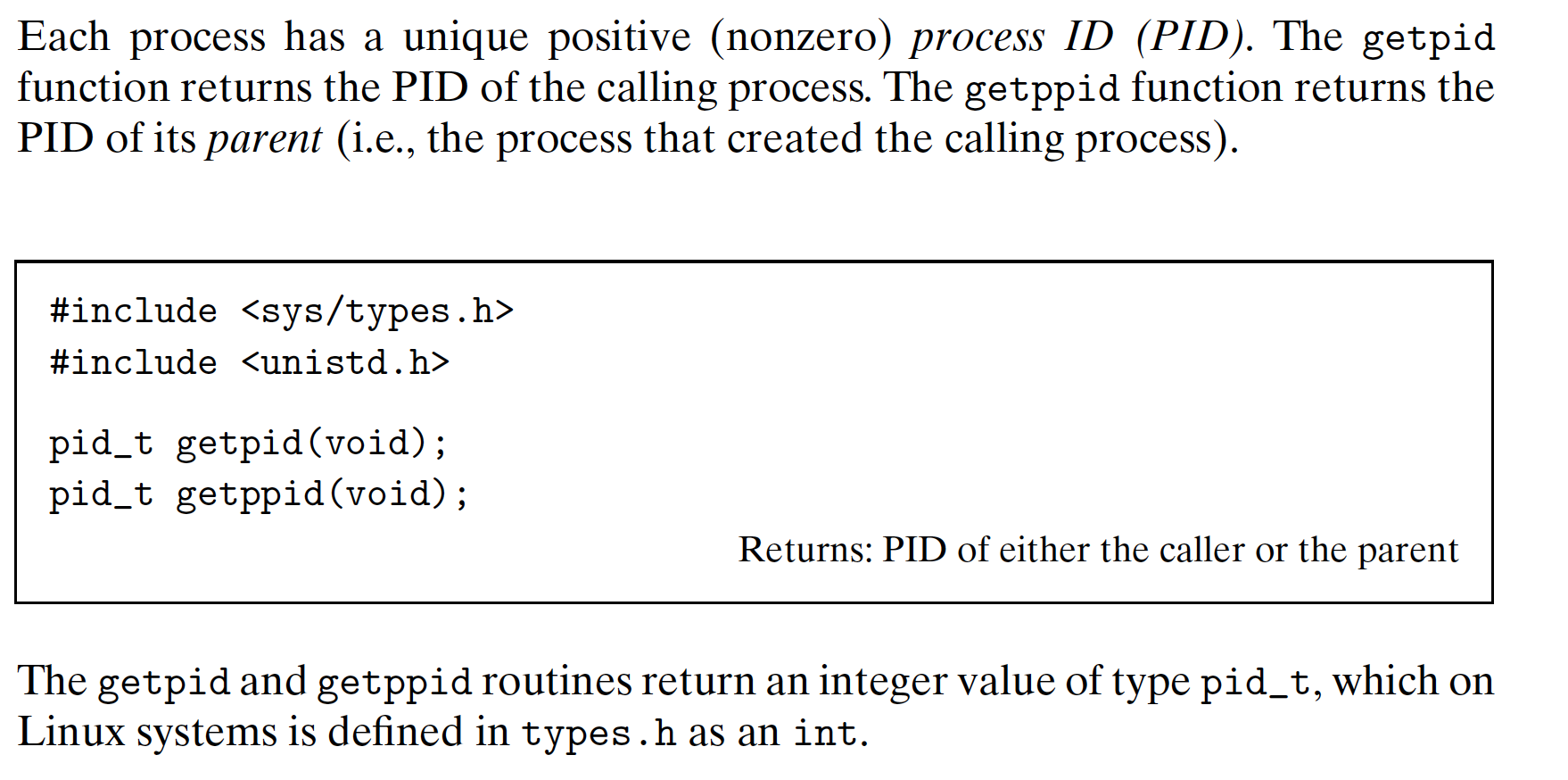
8.4.2 Creating and Terminating Processes

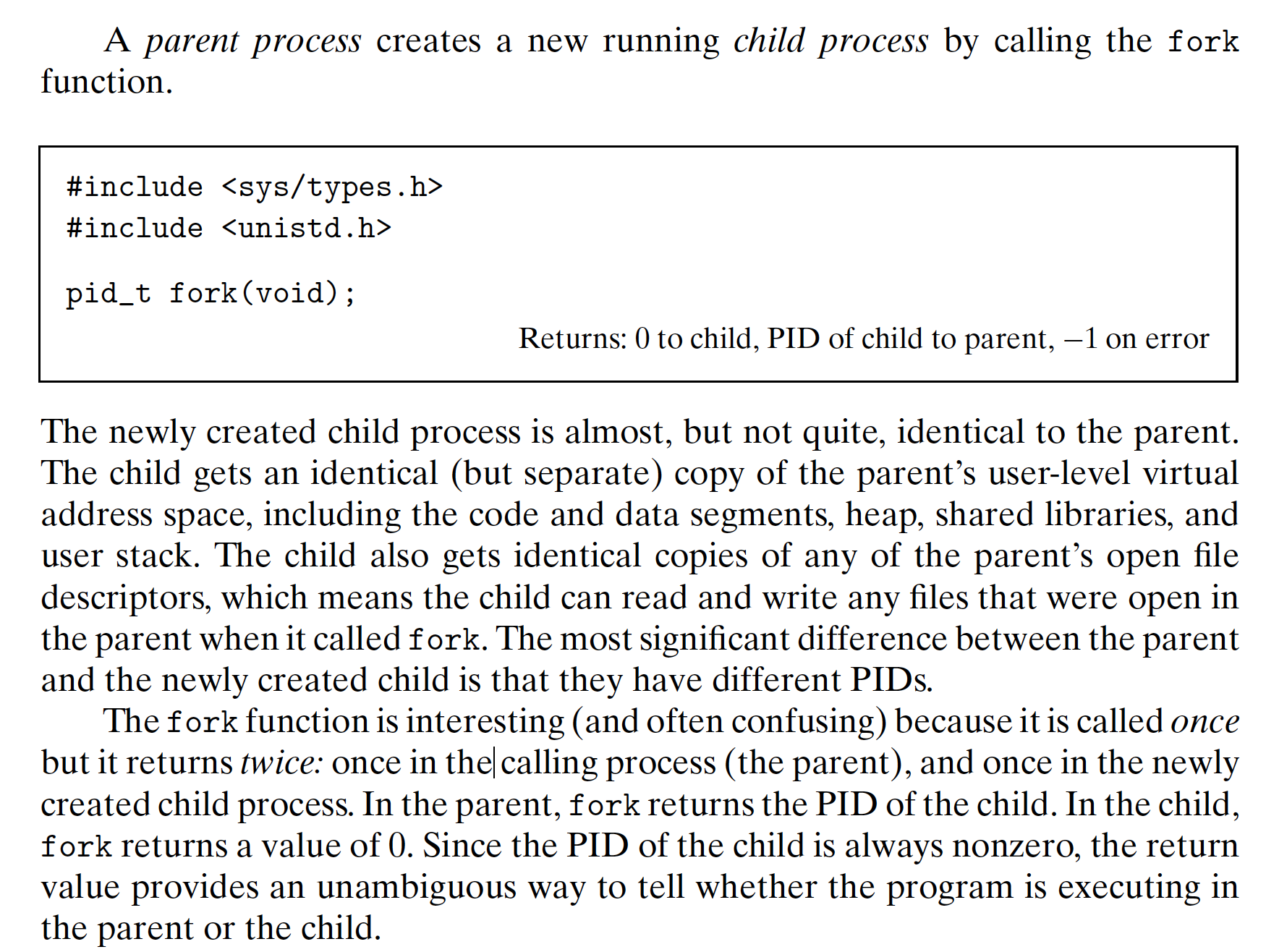
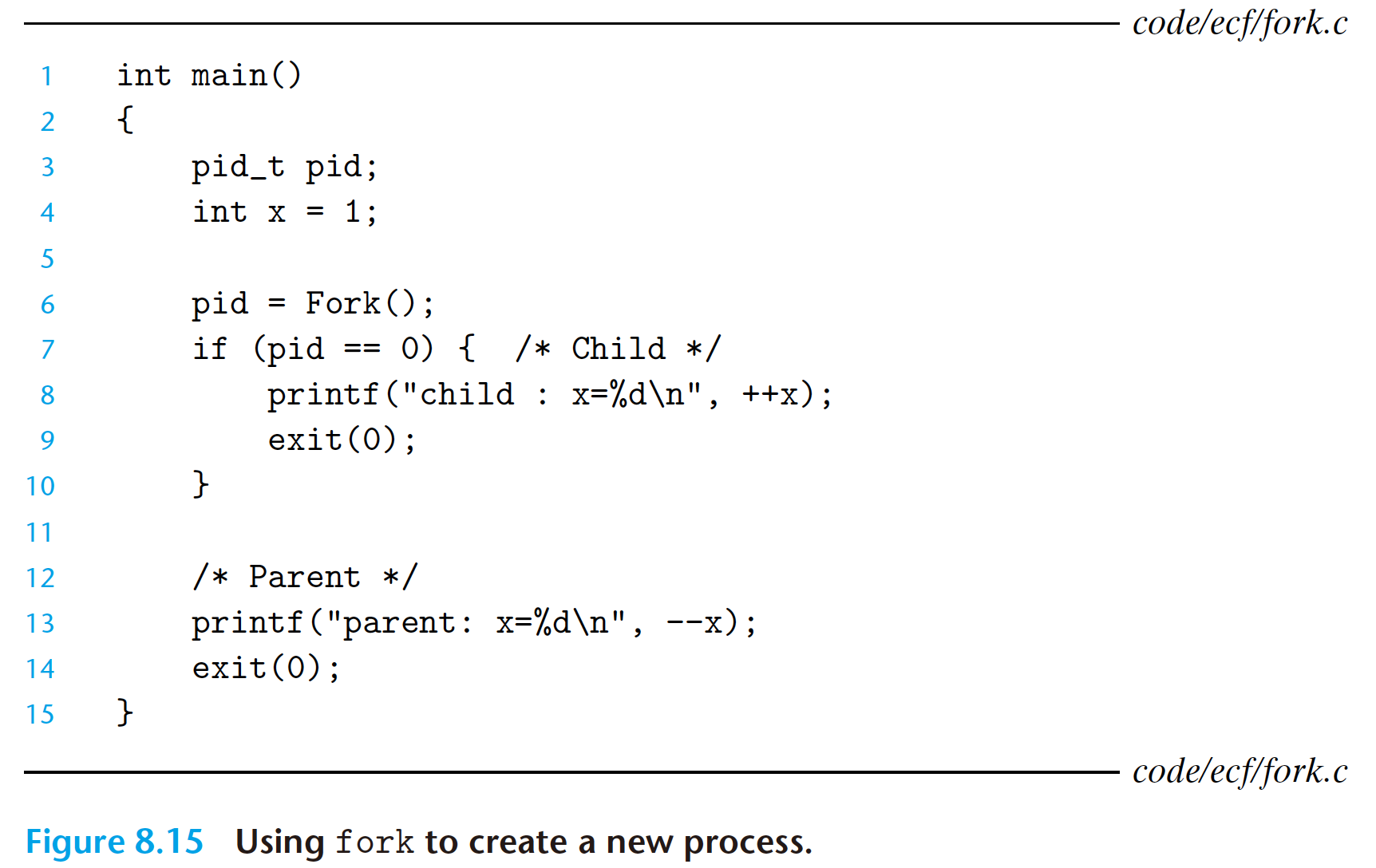
There are some subtle aspects to this simple example.
- Call once, return twice. The
forkfunction is called once by the parent, but it returns twice: once to the parent and once to the newly created child. This is fairly straightforward for programs that create a single child. But programs with multiple instances offorkcan be confusing and need to be reasoned about carefully. - Concurrent execution. The parent and the child are separate processes that
run concurrently. The instructions in their logical control flows can be interleaved by the kernel in an arbitrary way. When we run the program on our system, the parent process completes its
printfstatement first, followed by the child. However, on another system the reverse might be true. In general, as programmers we can never make assumptions about the interleaving of the instructions in different processes. - Duplicate but separate address spaces. If we could halt both the parent and the
child immediately after the
forkfunction returned in each process, we would see that the address space of each process is identical. Each process has the same user stack, the same local variable values, the same heap, the same global variable values, and the same code. Thus, in our example program, local variablexhas a value of 1 in both the parent and the child when theforkfunction returns in line 6. However, since the parent and the child are separate processes, they each have their own private address spaces. Any subsequent changes that a parent or child makes toxare private and are not reflected in the memory of the other process. This is why the variablexhas different values in the parent and child when they call their respectiveprintfstatements. - Shared files. When we run the example program, we notice that both parent and child print their output on the screen. The reason is that the child inherits all of the parent’s open files. When the parent calls fork, the
stdoutfile is open and directed to the screen. The child inherits this file, and thus its output is also directed to the screen.
8.4.3 Reaping Child Processes
When a process terminates for any reason, the kernel does not remove it from
the system immediately. Instead, the process is kept around in a terminated state
until it is reaped by its parent. When the parent reaps the terminated child, the
kernel passes the child’s exit status to the parent and then discards the terminated
process, at which point it ceases to exist. A terminated process that has not yet
been reaped is called a zombie.
When a parent process terminates, the kernel arranges for the init process to become the adopted parent of any orphaned children. The init process, which has a PID of 1, is created by the kernel during system start-up, never terminates, and is the ancestor of every process. If a parent process terminates without reaping its zombie children, then the kernel arranges for the init process to reap them. However, long-running programs such as shells or servers should always reap their zombie children. Even though zombies are not running, they still consume system memory resources.

The waitpid function is complicated. By default (when options = 0),
waitpid suspends execution of the calling process until a child process in its wait
set terminates. If a process in the wait set has already terminated at the time of the
call, then waitpid returns immediately. In either case, waitpid returns the PID of
the terminated child that caused waitpid to return. At this point, the terminated
child has been reaped and the kernel removes all traces of it from the system.
8.4.5 Loading and Running Programs
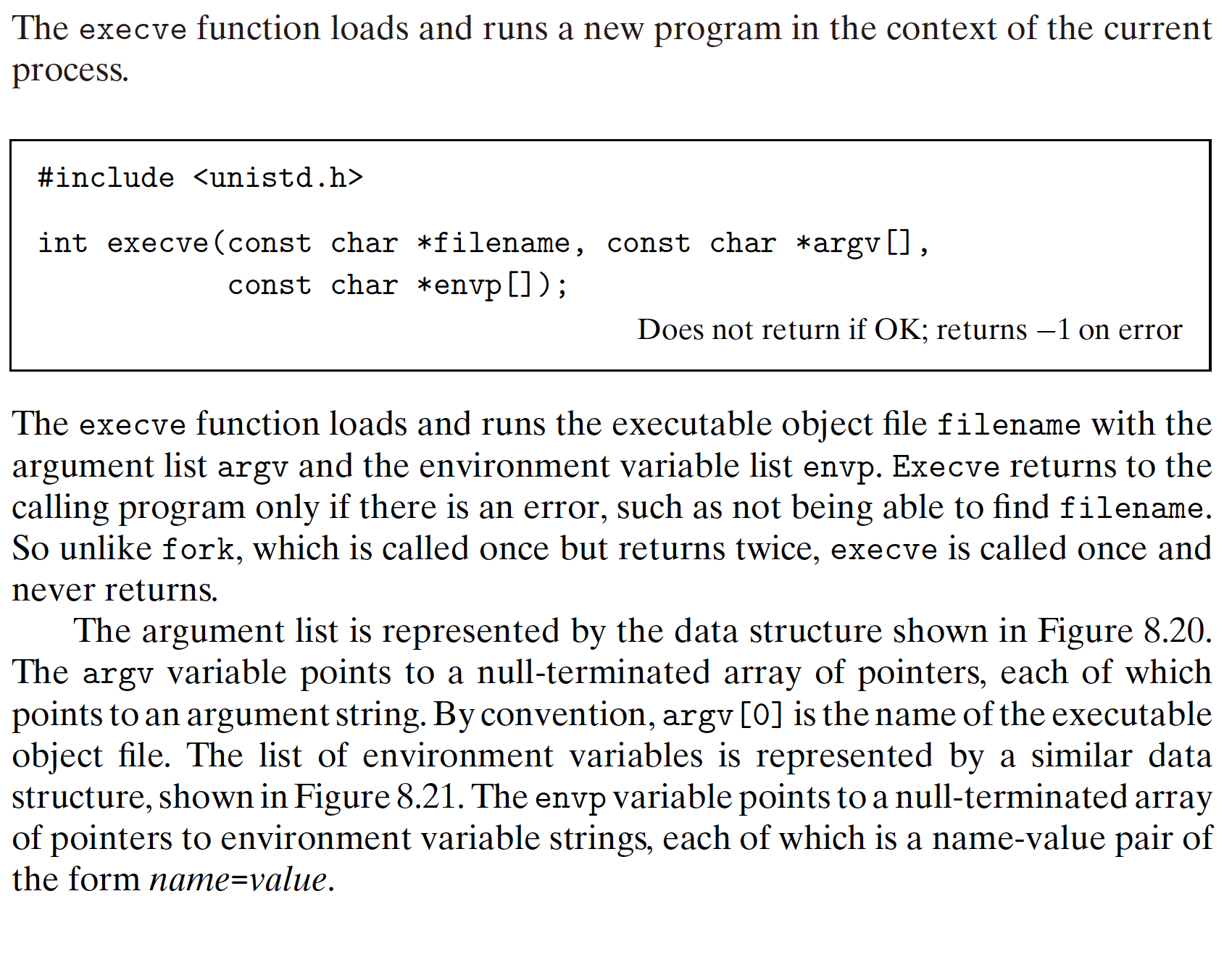

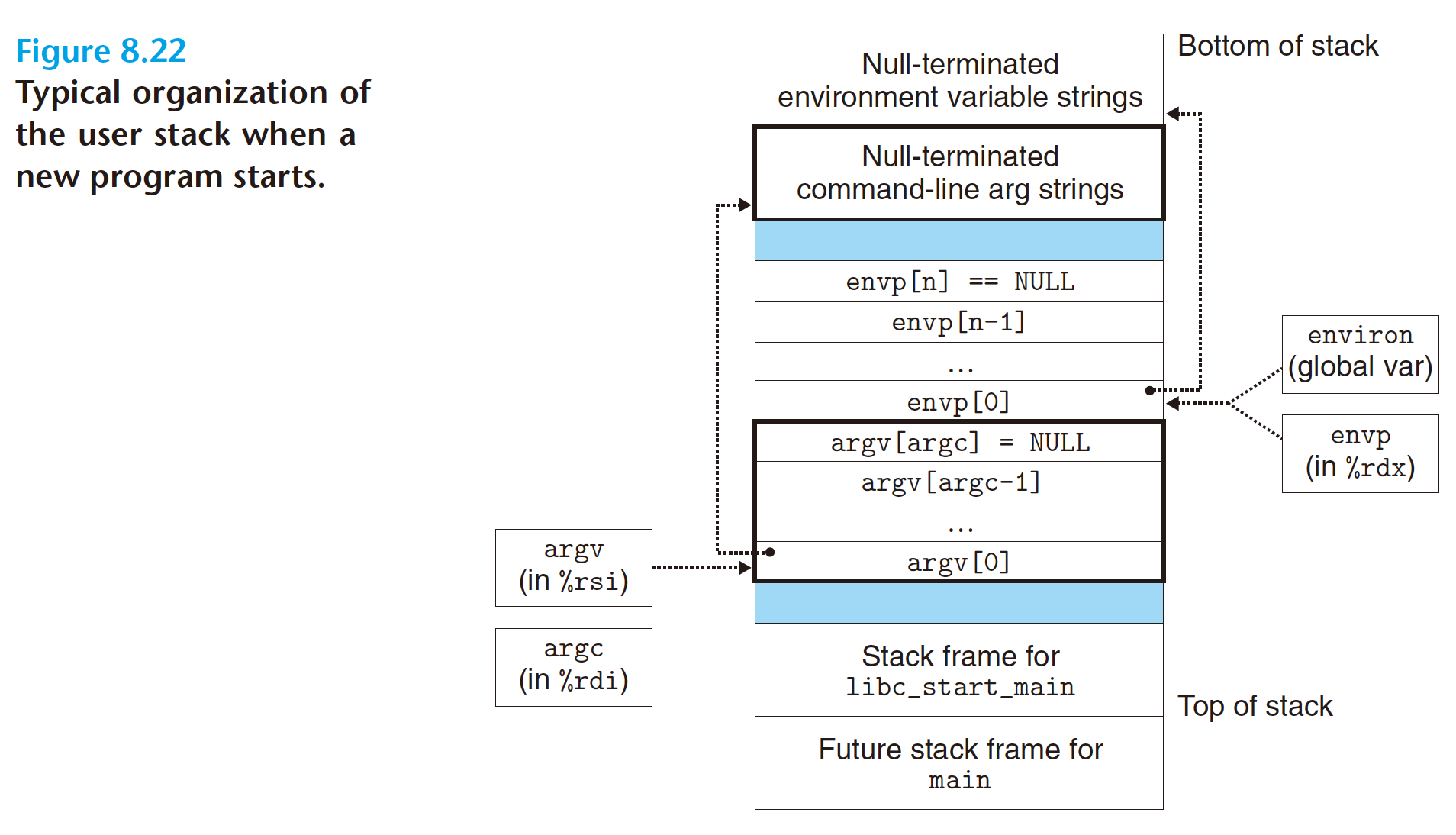
8.4.6 Using fork and execve to Run Programs
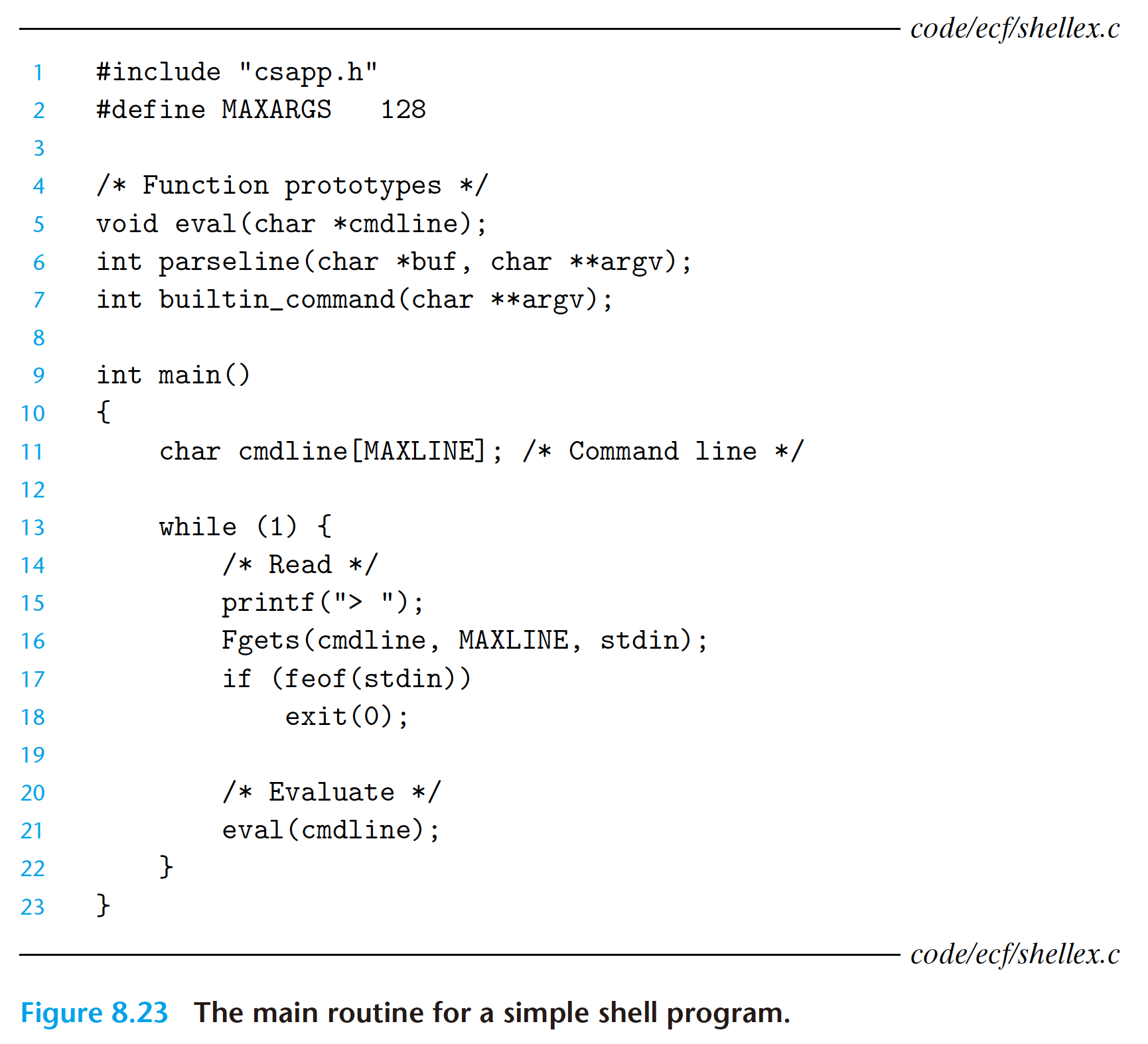


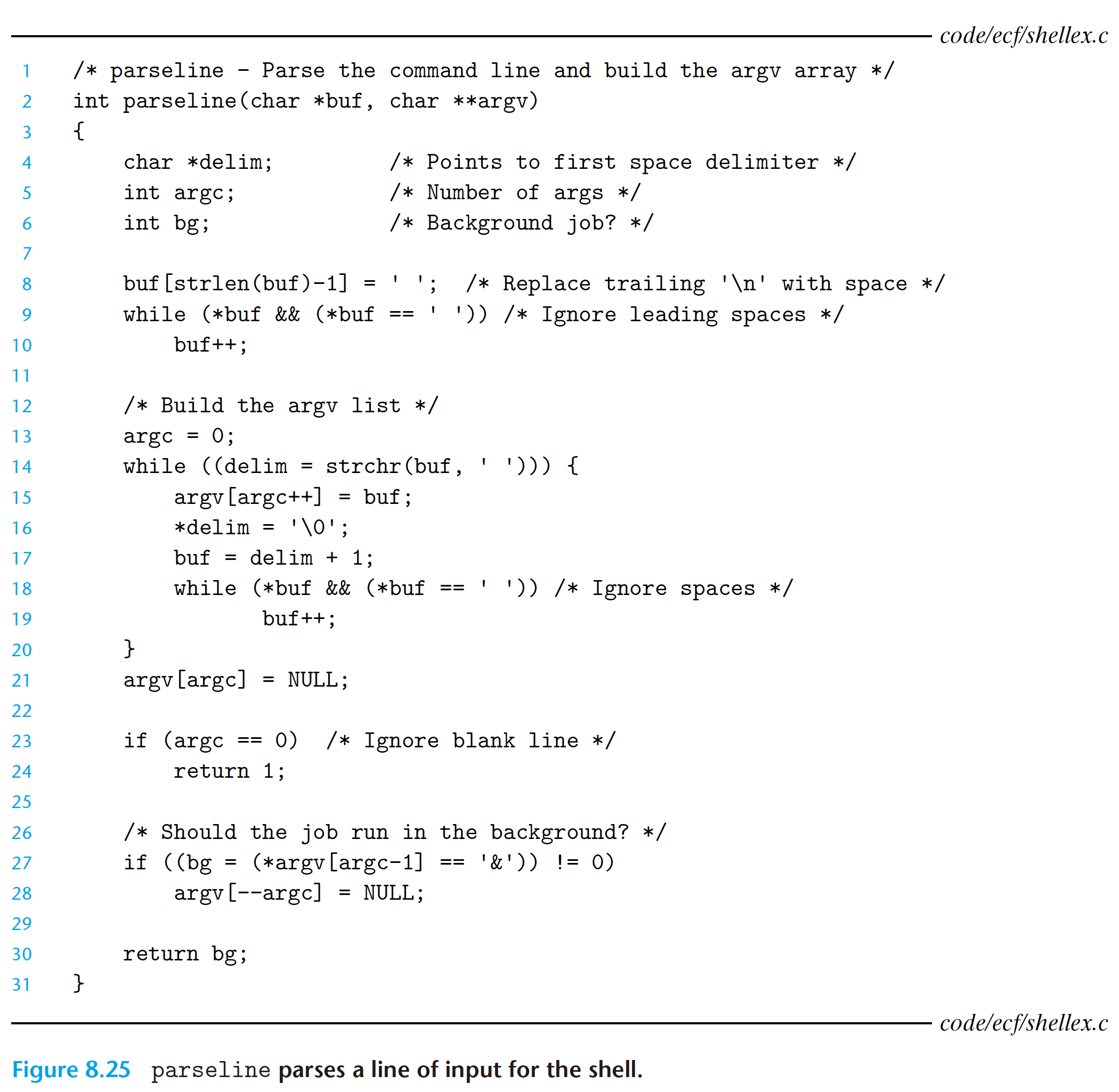
8.5 Signals
In this section, we will study a higher-level software form of exceptional control flow, known as a Linux signal, that allows processes and the kernel to interrupt other processes.

A signal is a small message that notifies a process that an event of some type has occurred in the system. Each signal type corresponds to some kind of system event. Low-level hardware exceptions are processed by the kernel’s exception handlers and would not normally be visible to user processes. Signals provide a mechanism for exposing the occurrence of such exceptions to user processes. For example, if a process attempts to divide by zero, then the kernel sends it a SIGFPE signal (number 8). If a process executes an illegal instruction, the kernel sends it a SIGILL signal (number 4). If a process makes an illegal memory reference, the kernel sends it a SIGSEGV signal (number 11). Other signals correspond to higher-level software events in the kernel or in other user processes. For example, if you type Ctrl+C (i.e., press the Ctrl key and the ‘c’ key at the same time) while a process is running in the foreground, then the kernel sends a SIGINT (number 2) to each process in the foreground process group. A process can forcibly terminate another process by sending it a SIGKILL signal (number 9). When a child process terminates or stops, the kernel sends a SIGCHLD signal (number 17) to the parent.
8.5.1 Signal Terminology
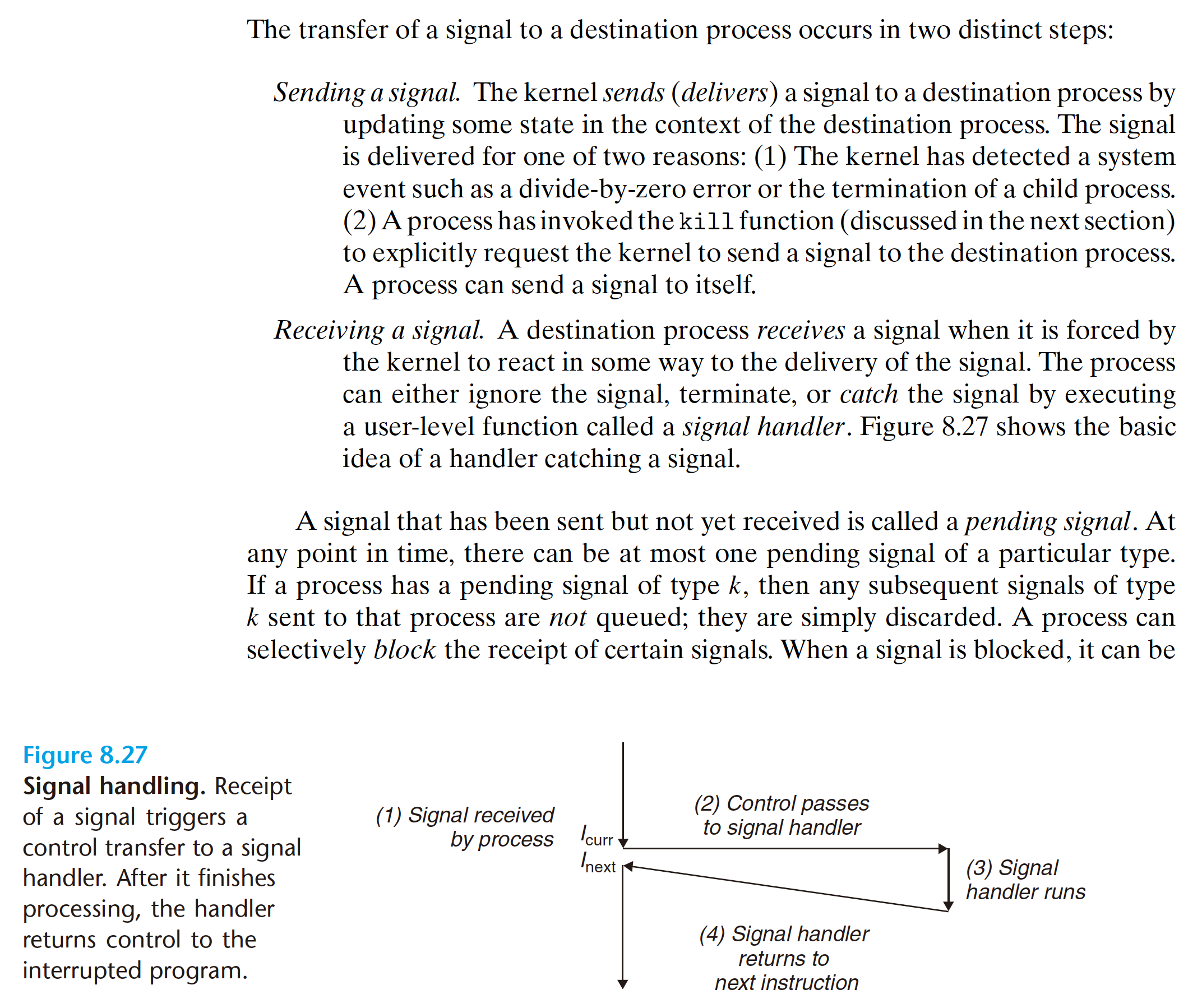
A pending signal is received at most once. For each process, the kernel maintains
the set of pending signals in the pending bit vector, and the set of blocked
signals in the blocked bit vector. The kernel sets bit k in pending whenever a
signal of type k is delivered and clears bit k in pending whenever a signal of type
k is received.
8.5.2 Sending Signals
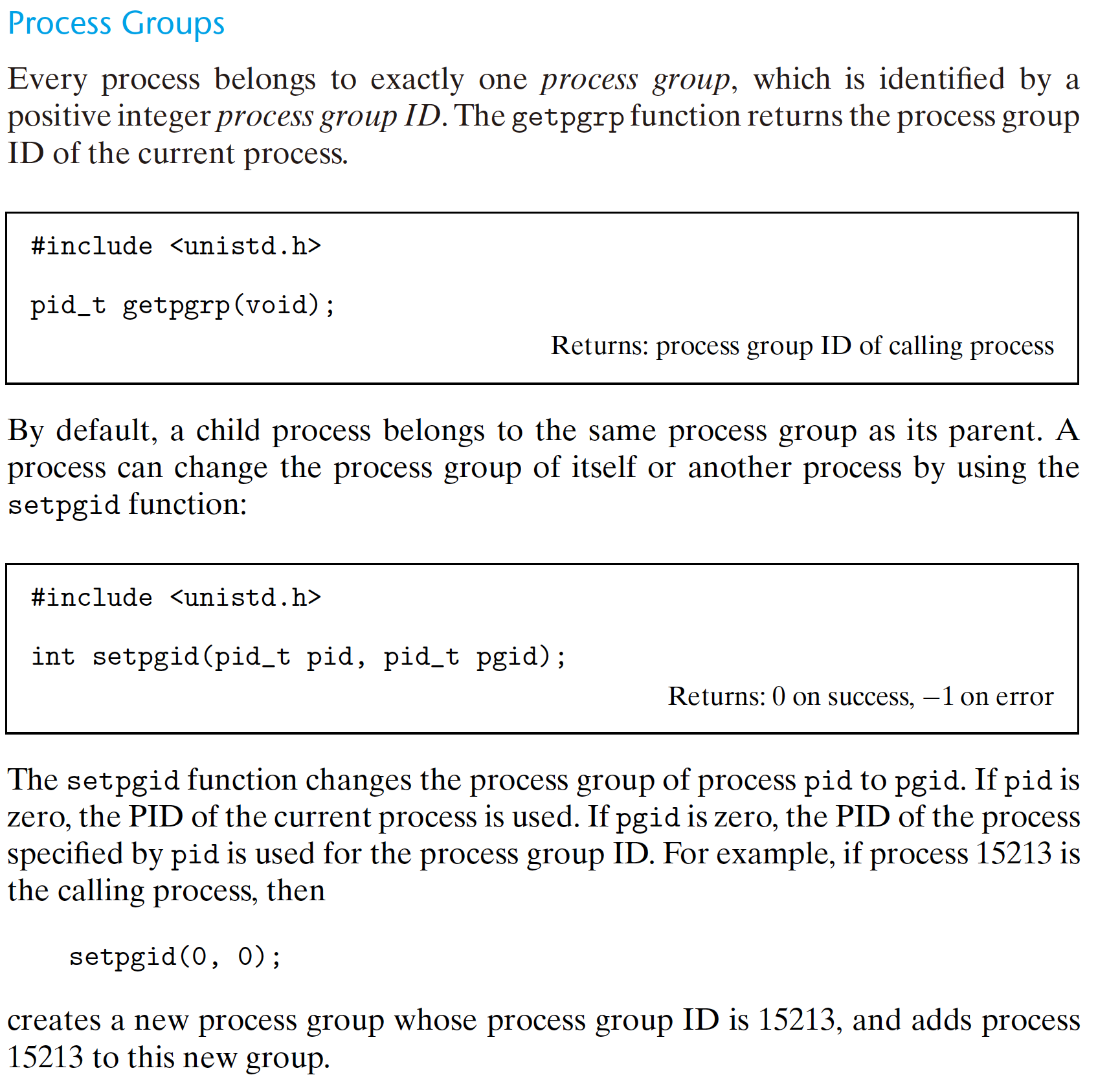

8.5.3 Receiving Signals
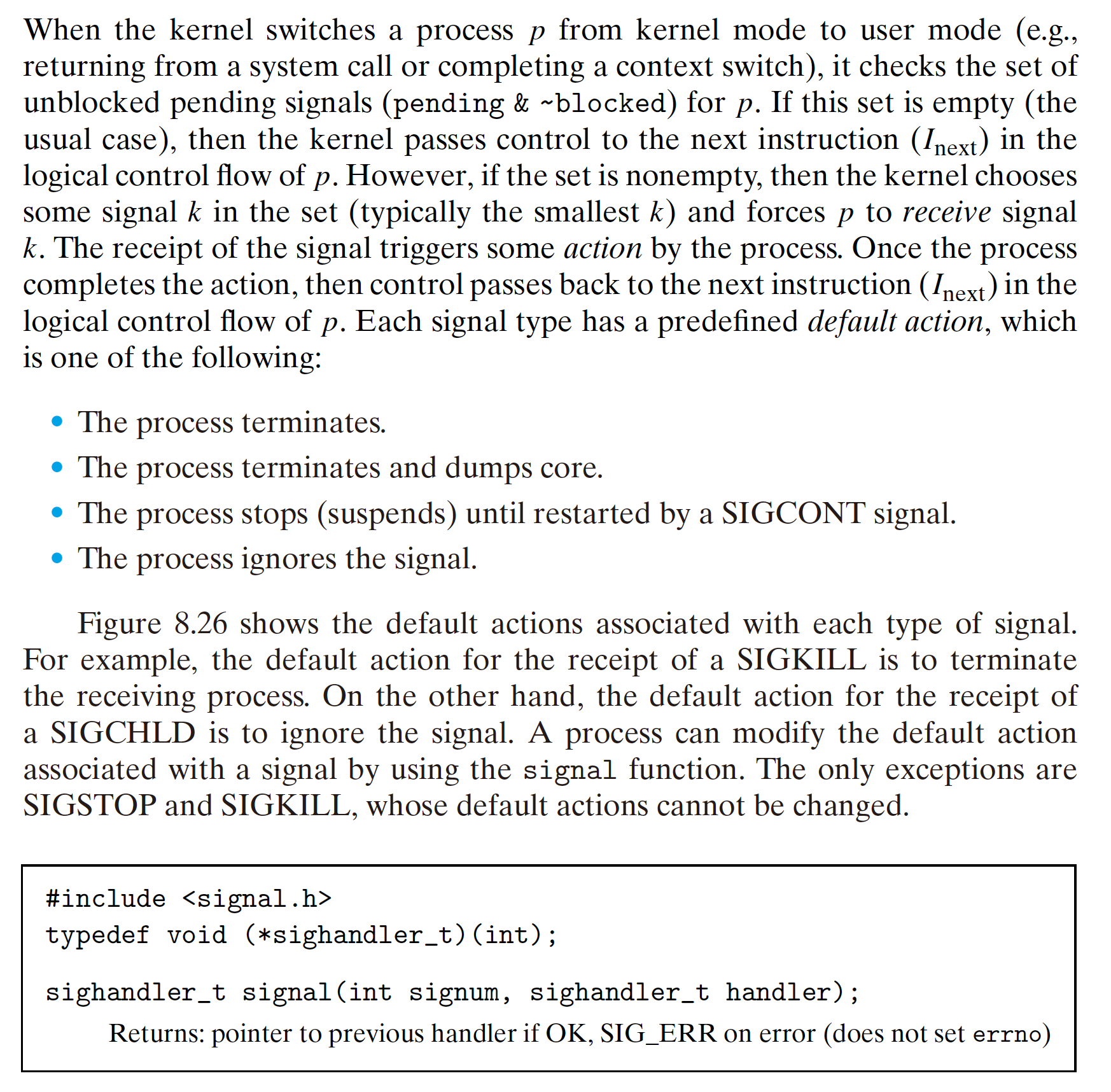
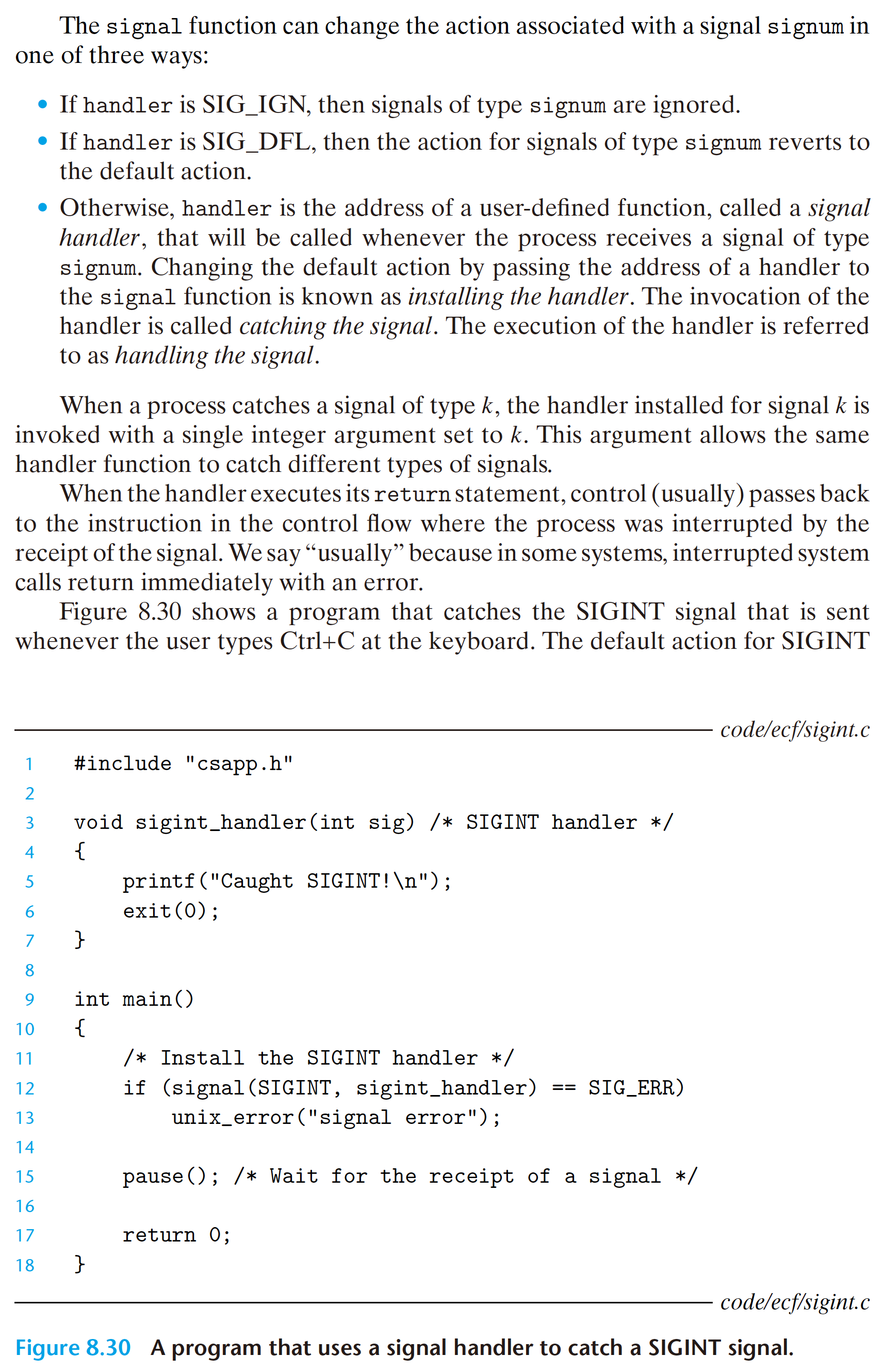
8.5.4 Blocking and Unblocking Signals
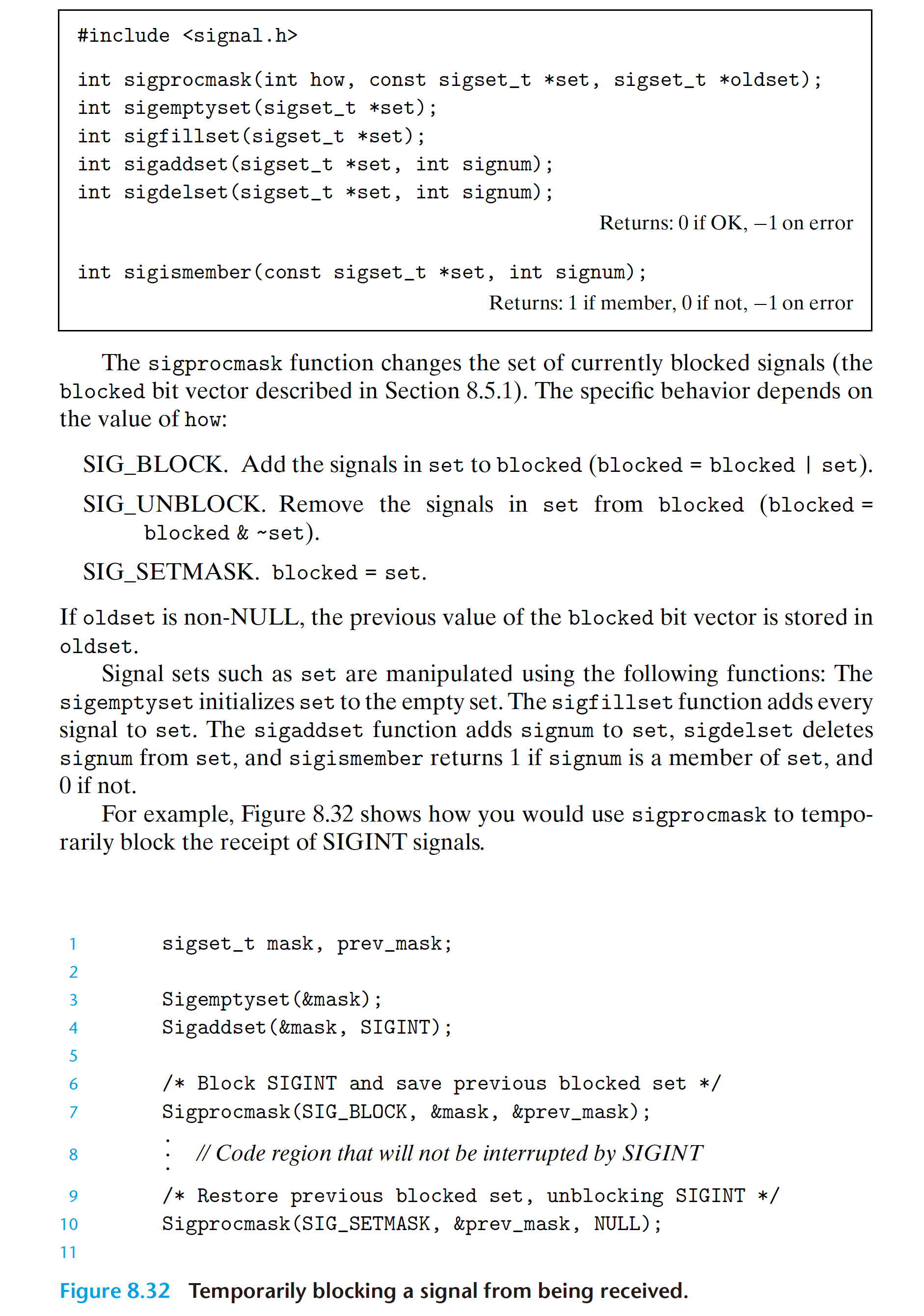
8.5.5 Writing Signal Handlers
